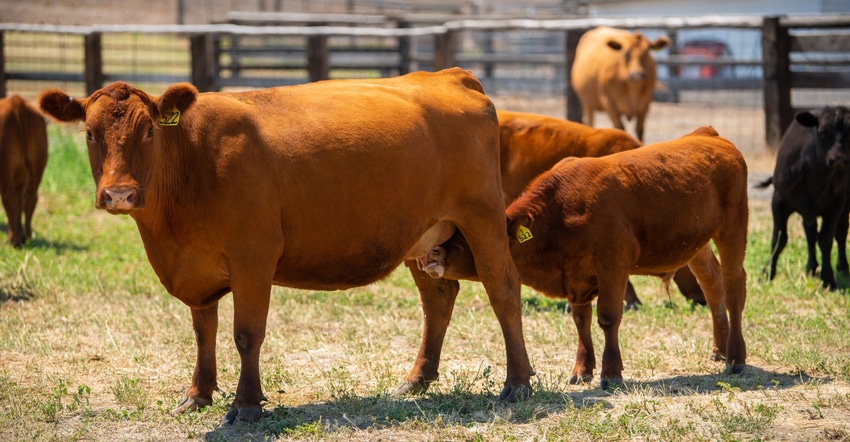
Beef producers and economists shared the witness table at an unprecedented Senate Agriculture Committee hearing on June 23 -“Examining Markets, Transparency, and Prices from Cattle Producer to Consumer” - to allow senators to hear first-hand more about the many challenges facing the beef sector.
The hearing started off with a stark message from South Dakota auctioneer and cow-calf producer Justin Tupper that many cattle producers are receiving less than a 1% return, while the gross profit margin for packers are over 80%.
While packers are making “unbelievable profits,” cattle producers are going out of business and consumers are paying double or triple at the grocery store, Tupper says.
He argues producers today no longer have a competitive market as a mere four companies control nearly 80% of the cattle processing supply. Previously four or five bidders would offer prices to producers for their cattle, however, the fat cattle trade today often doesn’t have a second bidder. “There’s simply not enough market participants,” Tupper explains.
The second bidder offers that competition and prevents a single buyer from setting a price and exerting market power. “The only way to have price discovery is to have a second bidder,” Tupper says.
“In traditional market times it was assumed when boxed beef prices rose, packers would ramp up chain speed to increase profits. Instead, they’re using limited chain speed and shackle space to increase profits and make the same money or more harvesting less cattle,” Tupper says. “So, producers see huge losses of equity while the packers reap all the rewards despite having the least amount of risk and owning the product the least amount of time.”
From 2000 to 2015, the U.S. beef industry experienced a net decline of roughly 14,000 head per day in fed cattle processing capacity, testified Dustin Aherin, animal protein analyst at Rabobank. Some efforts are going on to bring some new capacity back online, but it comes at a high cost.
If all of the announced plans for plant construction and expansion come to fruition, roughly 8,000 head of daily fed cattle capacity and nearly 2,000 head of daily non-fed capacity could be added to the US beef industry over the next five years, Aherin adds.
“A note of caution. There is a point where industry capacity expansion goes too far to withstand cyclical periods of tight cattle supplies. The long-term cattle cycle, drought risks, and market fundamentals must be considered,” he warns.
Unintended consequences
Meanwhile, Mark Gardiner, the owner-operator of Kansas-based Gardiner Angus Ranch and a member of the National Cattlemen’s Beef Association, explains what caused the most recent turmoil in the beef marketplace is not complicated.
“A processing plant fire, a pandemic and a ransomware attack caused an unusual and extraordinary disruption in the processing system resulting in a drop in processed beef supply and a bulging over supply of live cattle,” Gardiner says.
Gardiner says the solution is complicated, and one component is adjusting capacity which some processors are doing. Mandating cash trades or eliminating current trading tools is not the answer.
“This additional capacity will take time, but mark my words, history tells us we will likely reach a point where there is ample processing capacity for a limited supply of cattle, and the marketplace will shift once more where the producer will garner increased price leverage,” he told members.
In his opening remarks, Gardiner confirmed the importance of solutions that put producers in the driver’s seat, and he voiced support for alternative marketing arrangements that allow he and others like him to capitalize on negotiated offers that he says offer up to a $100/head premium.
“Please do not create regulations and legislation that have the unintended consequence of harming value-based marketing. Doing so would undo many years of progress for producers such as my family and those of our customers,” says Gardiner. “Onerous legislation has the potential to result in a reversal of quality that is simply unacceptable to consumers.”
Gardiner warns: “The question for us, in the meantime, is how much damage will regulations do to the marketplace by artificially manipulating the pricing mechanisms? History again tells us the unintended consequences of the actions taken here can create longer lasting havoc and even greater volatility in our industry.”
LMR changes
A key discussion point within the hearing also focused on what changes may be needed as Congress looks to reauthorize the Livestock Mandatory Reporting set to expire at the end of September.
Glynn Tonsor, Kansas State University ag economist, encourages LMR to not only be reauthorized but for enhancements to be considered. “We honestly need to assess if LMR can help in discovery, reporting and the transparency component.”
More research is needed on the types of information contemporary markets need and how to most effectively collect and disseminate that information, Tonsor adds.” Potential exists for the industry to largely sustain practices desired by many buyers and sellers while gaining confidence in reported market information.”
Support is growing for the creation of a contract library, similar to what is done in the swine industry.
Read more about:
Meat ProcessingAbout the Author(s)
You May Also Like






